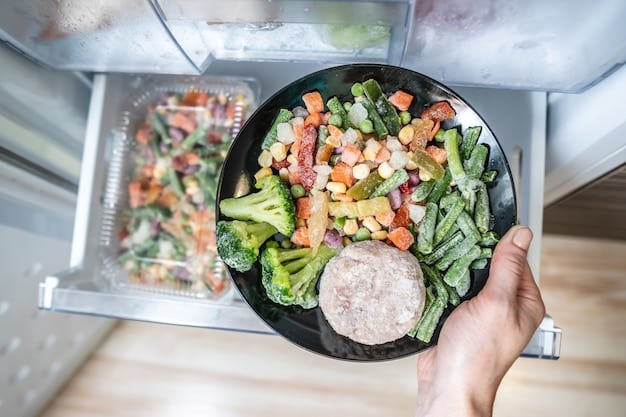Maximize Your Savings: Strategic Meal Planning for Grocery Savings

Maximize Your Savings: A Step-by-Step Guide to Strategic Meal Planning for Grocery Savings offers actionable strategies to reduce grocery bills, minimize food waste, and promote healthier eating habits through effective meal planning.
Are you looking for ways to cut down on your grocery expenses? Maximize Your Savings: A Step-by-Step Guide to Strategic Meal Planning for Grocery Savings, and you’ll discover how a little planning can lead to significant savings, less food waste, and healthier meals.
Understand Your Spending Habits
Before diving into meal planning, it’s crucial to understand where your money currently goes. Analyzing your spending habits provides a clear picture of areas where you can cut back and optimize your grocery budget.
Track Your Expenses
Begin by tracking your grocery expenses for a month. Use a budgeting app, spreadsheet, or even a notebook to record every purchase. Categorize your spending to identify where most of your money is being spent.
Identify Spending Patterns
Once you’ve tracked your expenses, look for patterns. Are you buying a lot of pre-packaged snacks? Do you tend to impulse buy when you’re hungry? Identifying these patterns allows you to make informed decisions about your meal plan.

- Review Past Receipts: Look through old grocery receipts to see what you typically buy.
- Use Budgeting Apps: Apps like Mint or YNAB can help you track your spending automatically.
- Categorize Purchases: Group your purchases into categories like produce, meat, dairy, and snacks.
Understanding your spending habits is the first step toward creating a more efficient meal plan. By knowing where your money goes, you can identify areas for improvement and make smarter choices at the grocery store.
Set a Realistic Grocery Budget
Setting a realistic grocery budget is essential for effective meal planning and savings. Your budget should be based on your income, expenses, and spending habits, ensuring it’s achievable and sustainable.
Assess Your Financial Situation
Start by assessing your overall financial situation. Determine your monthly income, fixed expenses (rent, utilities, etc.), and discretionary spending. Allocate a reasonable amount for groceries based on what’s left over.
Research Average Costs
Research the average cost of groceries in your area. Websites like Numbeo provide data on the average prices of various food items. This can help you set a budget that aligns with local prices.
Creating a realistic grocery budget involves considering your financial situation, understanding local costs, and setting achievable goals. This ensures that your meal plan is both effective and sustainable in the long run.
Plan Your Meals for the Week
Meal planning is the cornerstone of saving money on groceries. By planning your meals in advance, you can reduce impulse buys, minimize food waste, and make healthier choices. Here’s how to plan effectively.
Choose Your Recipes
Start by selecting the recipes you want to make for the week. Consider your schedule and choose meals that fit your available time. Look for recipes that use similar ingredients to minimize waste.
Check Your Pantry
Before making your grocery list, check your pantry, refrigerator, and freezer. Note what ingredients you already have on hand to avoid buying duplicates. This also helps you use up existing food before it expires.

- Theme Nights: Assign themes to each night (e.g., Meatless Monday, Taco Tuesday) to simplify recipe selection.
- Batch Cooking: Prepare ingredients in bulk (e.g., chopping vegetables, cooking grains) to save time during the week.
- Use Leftovers: Plan to use leftovers in creative ways, such as turning leftover roast chicken into chicken salad or soup.
Effective meal planning is all about preparation and strategy. By choosing recipes in advance, checking your pantry, and creating a detailed grocery list, you can reduce impulse buys and make the most of your grocery budget.
Create a Detailed Grocery List
A detailed grocery list is your best defense against impulse buys and unnecessary spending. By sticking to your list, you’ll only buy what you need, minimizing waste and maximizing savings.
Organize by Store Layout
Organize your grocery list according to the layout of your local grocery store. This makes shopping more efficient and reduces the chances of wandering into aisles you don’t need to visit.
Include Specific Quantities
Specify the exact quantities you need for each item. Instead of writing “tomatoes,” write “2 tomatoes.” This prevents you from overbuying and helps you stick to your meal plan.
Creating a detailed grocery list that’s organized and specific is essential for staying on budget. By planning your purchases in advance, you can avoid impulse buys and make the most of your grocery budget.
Shop Smart at the Grocery Store
Shopping smart at the grocery store involves more than just sticking to your list. It’s about being strategic with your purchases and taking advantage of deals and discounts.
Compare Unit Prices
Always compare unit prices to determine the best value. The unit price is the cost per ounce, pound, or other unit of measurement. This helps you compare different brands and package sizes.
Look for Sales and Discounts
Take advantage of sales, discounts, and coupons. Check your grocery store’s weekly ad for deals and look for coupons online or in newspapers. Many stores also offer digital coupons that you can load onto your loyalty card.
Creating a smart shopping strategy involves comparing prices, taking advantage of sales, and avoiding impulse buys. By being mindful and strategic, you can make the most of your grocery trips and save money.
Cook Strategically and Minimize Waste
Cooking strategically and minimizing waste are crucial for saving money and promoting sustainability. By using leftovers creatively and storing food properly, you can reduce waste and make the most of your ingredients.
Store Food Properly
Store food properly to extend its shelf life. Use airtight containers to prevent spoilage and store produce in the refrigerator crisper drawers. Properly storing food can significantly reduce waste.
Use Leftovers Creatively
Plan to use leftovers in creative ways. Turn leftover roast chicken into chicken salad or soup. Use leftover vegetables in stir-fries or omelets. Getting creative with leftovers prevents waste and saves you time and money.
Cooking strategically and minimizing waste is about being mindful of your food and using it efficiently. By storing food properly, using leftovers creatively, and composting food scraps, you can reduce waste and save money.
| Key Point | Brief Description |
|---|---|
| 💰 Track Expenses | Monitor where your grocery money goes to identify savings opportunities. |
| 🗓️ Plan Meals | Reduce impulse buys and waste by planning your meals for the week. |
| 📝 Grocery List | Stick to your list to avoid unnecessary purchases. |
| 🍎 Smart Shopping | Compare prices and use discounts to maximize savings. |
FAQ
▼
Strategic meal planning involves carefully planning your meals for the week, creating a grocery list based on those meals, and then shopping with a clear intention to minimize waste and save money.
▼
Meal planning saves money by reducing impulse purchases, minimizing food waste (since you only buy what you need), and allowing you to take advantage of sales and discounts more effectively.
▼
Stick to your detailed grocery list, avoid shopping when hungry, compare unit prices to find the best deals, and take advantage of coupons and store loyalty programs to maximize savings.
▼
Plan meals that use similar ingredients, store food properly to extend its shelf life, and get creative with leftovers by incorporating them into new dishes to minimize waste.
▼
Use meal planning apps like Plan to Eat or Mealime, budgeting apps like Mint or YNAB, and online recipe resources to find meal inspiration and organize your grocery lists effectively.
Conclusion
By implementing these strategic meal planning tips, you can maximize your savings, reduce food waste, and enjoy healthier, more cost-effective meals. Start planning today and see the positive impact on your budget and lifestyle.





